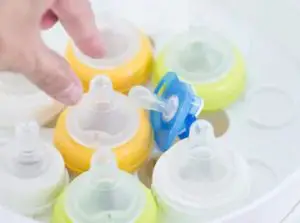Table of Contents
Introduction
Of course, you can never use the same bottle nipples for the whole year. Even if your baby’s bottle nipples are well taken care of, there is still a recommended time for bottle nipple replacement. There are two main reasons why bottle nipples should be changed or replaced, changing nipple sizesand during signs of wear and tear or as recommended. If you are a new parent who’s still confused whether to replace the bottle nipples or not, then read on. We are here to help you figure things out.
When to Replace Bottle Nipples
There are ways to make your baby bottle nipples sturdy and long-lasting. Of course, it is important that choose the best nipples out in the market to make sure that they are of good quality. Second is to sterilize your bottle nipples and keep them clean. So when should you replace your baby’s bottle nipples?
Discolouration
Staining or changes in colour should be noted since this could be a sign that you have been using the nipples for quite a long time. It could also be a sign that it was not properly cleaned, or you may have used cleaning solutions that are not suitable for the bottle nipples. The discolouration is also a sign that the bottle nipples are already deteriorating.
Sticky Texture
Over time, your baby bottle nipples may develop a sticky surface or texture. Stickiness is due to improper cleaning or sterilization. A sticky baby bottle nipple may also be an effect of bacterial contamination. So if you happen to notice this sign, it is important that you immediately toss the old nipple and replace it with a new one.
Changes in Shape
When the nipples tend to be swelling or by any way has noticeable changes in shape, then you should already replace it and get a new one. Swelling is also a significant sign that the bottle nipple is already deteriorating.
Thinning
One way to check if your baby’s bottle nipple is thinning is through pulling the tip of the bulb. The nipple should rebound or return to its original shape, if it doesn’t or if it stretches out, then you throw it and get a new one. Thinning is a sign of losing elasticity and strength. If you aren’t able to replace it, your baby might tear it during the next feeding.
Any Sign of Damage
Signs of damage on nipples include cracks, tears, and an expanded or a larger hole. If you notice these signs on, you should dispose of the nipple immediately since this can eventually and become a choking hazard for your baby.
Irregular Milk Flow
Formula milk or breast milk should be flowing out steadily through the hole at the tip of the bottle nipple. If the flow becomes too fast, it is a result of an expanded or enlarged hole, and the nipple should be replaced immediately.
Cleaning and Care
The best and simplest way to keep your baby bottle nipples is to make sure they are always clean and stored properly. When it comes to cleaning, you should be using soaps that are safe for baby items, also use a brush with gentle and soft bristles. Before first use, remember to sterilize your nipples and bottles before use properly. Also, remember to clean nipples immediately after use to avoid clogging, and bacteria build-up that may result in deterioration.
Properly storing bottle nipples is also another way in improving the longevity of bottle nipples. Make it a habit to check them before use, and if you notice signs of wear and tear or deterioration, throw those nipples away immediately. Remember to practice good hand hygiene when handling your baby’s bottle nipples and other feeding materials.
Facts about Bottle Nipples
Bottle nipples are made from different materials.
Baby bottle nipples can be made from either latex or silicone.
Latex ones tend to be more soft and flexible; they are easy to clean too. But since latex is softer, they tend to wear out pretty quickly compared to silicone. Also, if your baby develops allergic reactions to latex nipples, immediately switch to silicone nipples.
Silicone nipples are more durable, thicker, and holds nipple shape better and longer. Nipples made from silicone are easy to clean too.
Bottle nipples have different sizes.
Baby bottle nipples come in different sizes and flow rates. This topic is thoroughly discussed in this article: Avent Nipple Sizes, When to Change.
Bottle nipples are created in different shapes.
Baby bottle nipples come in different shapes to allow comfort in babies while feeding. They can be flat, wide, dome-shaped, or narrow. The flat or wide ones are best for those who breastfeed and bottle feed at the same time since these nipples are shaped to mimic a mother’s breast. You may try different shapes to see which one your baby would prefer.
Conclusion
Generally, a baby bottle nipple should be replaced at an average of two to three months of usage. However, if you already see signs of damages or deterioration, don’t hesitate to toss or throw them away. Your babies deserve only the best, so it is important that you don’t only feed them with the most nutrition, but provide them also with the best feeding items out there!

